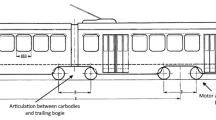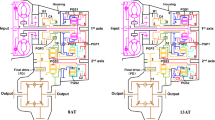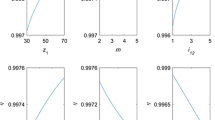Abstract
In order to explore the influence of the traction motor layout mode on the dynamic characteristics of rack vehicles and some nonlinear dynamic behaviors, and to propose the optimal layout of the traction motor of rack vehicles, the three-dimensional (3D) dynamic model of rack vehicle is established for the first time. The model considers the gear/rack nonlinear meshing behavior and the wheel/rail nonlinear contact relationship. The calculation method of time-varying dynamic excitation force is given. The motor layout mode of rack vehicle can be divided into front-mounted (FM) mode, rear-mounted (RM) mode, and dual-mounted (DM) mode. Adopting the model, the vehicle nonlinear dynamic characteristics under different traction motor layout modes are investigated, and the impact of three different driving forms on the vehicle is also studied. Results show that the gear/rack meshing characteristics of the vehicle in the DM mode are the best. The nonlinear motion of the gear system is quasi-periodic, and the stability is better when climbing. The vehicle in the DM mode is the smoothest in the straight section. Nevertheless, the nonlinear critical speed of rack vehicle is greatly reduced and it is easier to lose stability. The vehicle in the DM mode is the smoothest in the straight section. When climbing, the running comfort in DM mode is better than that in RM and FM mode. The excellent rate of vehicle running stability in the DM mode is 66.7%, which is 44.5% higher than that in FM mode and is 55.6% than that in RM mode. With the same total driving power, the gear meshing force in FM mode and RM mode is about twice the DM mode. Based on the calculation results in this paper, it is recommended that the optimal layout mode is DM mode.






































Similar content being viewed by others
Data availability
The data that support the findings of this study are available from the corresponding author upon reasonable request.
Code availability
Not applicable.
References
Loomis, J., Keske, C.: The economic value of novel means of ascending high mountain peaks: A travel cost demand model of Pikes peak cog railway riders, automobile users and hikers, automobile users and hikers. Tour. Econ. 15, 426–436 (2009). https://doi.org/10.5367/000000009788254313
Hansen, B.: Gearing Up: The Mount Washington Cog Railway. Civ. Eng. 79, 36–39 (2009)
Yu, H., Zhang, Y., Chen, L.: Research on technical characteristics and application prospect of track railway. J. Railw. Eng. Soc. (in Chinese) 37, 6–10 (2020)
Grabovic, E., Gabiccini, M., Artoni, A.: A hybrid analytical/Boolean approach to the generation of rack and pinion drives with variable transmission ratio. Mech. Mach. Theory 160, 104–287 (2021). https://doi.org/10.1016/j.mechmachtheory.2021.104287
Tao, J., Smith, S., Duff, A.: The effect of overloading sequences on landing gear fatigue damage. Int. J. Fatigue 31, 1837–1847 (2009). https://doi.org/10.1016/j.ijfatigue.2009.03.012
Chen, Z., Zhai, W., Wang, K.: Vibration feature evolution of locomotive with tooth root crack propagation of gear transmission system. Mech. Syst. Signal Process. 115, 29–44 (2019). https://doi.org/10.1016/j.ymssp.2018.05.038
Liu, Y., Hong, T., Li, Z.: Influence of toothed rail parameters on impact vibration meshing of mountainous self-propelled electric monorail transporter. Sensors (Switzerland) 20, 1–22 (2020). https://doi.org/10.3390/s20205880
Liu, H., Li, S., Zhang, Y., et al.: Mechanical simulation and experiment of self-propelled monorail mountain orchard transporter under different racks. J. Huazhong Agric. Univ. 38, 114–122 (2019)
Nakamura, K., Okubo, K., Fujii, T., Uchida, S.: Optimum power contribution ratio of two pinion gears engaged with rack rail for monorail driven in forest industry. In: Proceedings of the AASRI Winter International Conference on Engineering and Technology (AASRI-WIET 2013), vol. 79 (2014). https://doi.org/10.2991/wiet-13.2013.8.
True, H., Trzepacz, L.: On the dynamics of a railway freight wagon wheelset with dry friction damping. Veh. Syst. Dyn. 38, 149–163 (2002)
Polach, O.: A new approach to define criteria for rail vehicle model validation. Veh. Syst. Dyn. 52, 125–141 (2014)
Polach, O., Nicklisch, D.: Wheel/rail contact geometry parameters in regard to vehicle behaviour and their alteration with wear. Wear 366–367, 200–208 (2016)
Schupp, G.: Bifurcation analysis of railway vehicles. Multibody Syst.Dyn. 15, 25–50 (2006)
Wang, J.H., Yang, J.W., Li, Q.: Quasi-static analysis of the nonlinear behavior of a railway vehicle gear system considering time-varying and stochastic excitation. Nonlinear Dyn. 93, 463–485 (2018). https://doi.org/10.1007/s11071-018-4204-3
Shi, H.L., Luo, R., Guo, J.Y.: Improved lateral-dynamics-intended railway vehicle model involving nonlinear wheel/rail interaction and car body flexibility. Acta Mech. Sin. (2021). https://doi.org/10.1007/S10409-021-01059-1
Xing, L.L., Wang, Y.M., Dong, X.Q.: Effect of the wheel/rail contact geometry on the stability of railway vehicle. In: IOP Conference Series: Materials Science and Engineering, vol. 392 (2018). DOI: https://doi.org/10.1088/1757-899X/392/6/062134
Chang-Jian, C.W., Chang, S.M.: Bifurcation and chaos analysis of spur gear pair with and without nonlinear suspension. Nonlinear Anal. Real World Appl. 12, 979–989 (2011)
Vaishya, M., Singh, R.: Analysis of periodically varying gear mesh systems with Coulomb friction using Floquet theory. J. Sound Vib. 243, 525–545 (2001)
Vaishya, M., Singh, R.: Sliding friction-induced non-linearity and parametric effects in gear dynamics. J. Sound Vib. 248, 671–694 (2001)
Gou, X.F., Zhu, L.Y., Chen, D.L.: Bifurcation and chaos analysis of spur gear pair in two-parameter plane. Nonlinear Dyn. 79, 2225–2235 (2015)
Ren, Z.H., Li, J.L., Wang, K., et al.: Nonlinear dynamic analysis of a coupled lateral-torsional spur gear with eccentricity. J. Vibroengineering 18, 4776–4791 (2016)
Zhai, W.M., Wang, K.Y., Cai, C.B.: Fundamentals of vehicle-track coupled dynamics. Veh. Syst. Dyn. 47(11), 1349–1376 (2009)
Liu, X.Y., Zhai, W.M.: Analysis of vertical dynamic wheel/rail interaction caused by polygonal wheels on high-speed trains. Wear 314, 282–290 (2014). https://doi.org/10.1016/j.wear.2013.11.048
Nevzat Özgüven, H., Houser, D.R.: Mathematical models used in gear dynamics—A review. J. Sound Vib. 121, 383–411 (1988). https://doi.org/10.1016/S0022-460X(88)80365-1
Piotrowski, J., Chollet, H.: Wheel–rail contact models for vehicle system dynamics including multi-point contact. Veh. Syst. Dyn. 43, 455–483 (2005). https://doi.org/10.1080/00423110500141144
Jalili, M.M., Salehi, H.: Wheel/rail contact model for rail vehicle dynamics. C.R. Mec. 339, 700–707 (2011). https://doi.org/10.1016/j.crme.2011.07.006
Kalker, J.J.: Wheel-rail rolling contact theory. Wear 144, 243–261 (1991). https://doi.org/10.1016/0043-1648(91)90018-P
Zhai, W.M., Sun, X.: A detailed model for investigating vertical interaction between railway vehicle and track. Veh. Syst. Dyn. 23, 603–615 (1994). https://doi.org/10.1080/00423119308969544
Hu, B., Zhou, C.J., Wang, H.B., et al.: Nonlinear tribo-dynamic model and experimental verification of a spur gear drive under loss-of-lubrication condition. Mech. Syst. Signal Process. 153, 107–509 (2021). https://doi.org/10.1016/j.ymssp.2020.107509
Zhang, N., Wang, M.: Dynamic modeling of hydraulic power steering system with variable ratio rack and pinion gear. JSME Int. J. Ser. C 48, 251–260 (2005). https://doi.org/10.1299/jsmec.48.251
General Administration of Market Supervision and Administration of the people's Republic of China. Specification for dynamic performance evaluation and test appraisal of locomotives and rolling stock: GB/T 5599–2019. Beijing: Standards Press of China, 2019.
Szabo, Z., Lorant, G.: Parametric Excitation of a Single Railway Wheelset. Veh. Syst. Dyn. 33, 49–55 (2000)
Acknowledgements
This work was supported by the National Natural Science Foundation of China [Grant Number: 52008067] and the Sichuan Science and Technology Program [Grant Number: 2021YFG0211].
Funding
This work was supported by the National Natural Science Foundation of China [Grant Number: 52008067] and the Sichuan Science and Technology Program [Grant Number: 2021YFG0211].
Author information
Authors and Affiliations
Contributions
Zhaowei Chen contributed to conceptualization, methodology, validation, investigation, writing—original draft, and writing—review and editing. Shihui Li performed validation, investigation, software, data curation, and writing—review and editing.
Corresponding author
Ethics declarations
Conflict of interests
The authors declare that they have no known competing financial interests or personal relationships that could have appeared to influence the work reported in this paper.
Ethics approval
Not applicable.
Consent to participate
Not applicable.
Consent for publication
Not applicable.
Additional information
Publisher's Note
Springer Nature remains neutral with regard to jurisdictional claims in published maps and institutional affiliations.
Rights and permissions
About this article
Cite this article
Chen, Z., Li, S. Dynamic evaluation and optimization of layout mode of traction motor in rack vehicle. Nonlinear Dyn 106, 3025–3050 (2021). https://doi.org/10.1007/s11071-021-06939-6
Received:
Accepted:
Published:
Issue Date:
DOI: https://doi.org/10.1007/s11071-021-06939-6




